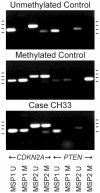Recurrent chromosomal copy number alterations in sporadic chordomas
- PMID: 21602918
- PMCID: PMC3094331
- DOI: 10.1371/journal.pone.0018846
Recurrent chromosomal copy number alterations in sporadic chordomas
Abstract
The molecular events in chordoma pathogenesis have not been fully delineated, particularly with respect to copy number changes. Understanding copy number alterations in chordoma may reveal critical disease mechanisms that could be exploited for tumor classification and therapy. We report the copy number analysis of 21 sporadic chordomas using array comparative genomic hybridization (CGH). Recurrent copy changes were further evaluated with immunohistochemistry, methylation specific PCR, and quantitative real-time PCR. Similar to previous findings, large copy number losses, involving chromosomes 1p, 3, 4, 9, 10, 13, 14, and 18, were more common than copy number gains. Loss of CDKN2A with or without loss of CDKN2B on 9p21.3 was observed in 16/20 (80%) unique cases of which six (30%) showed homozygous deletions ranging from 76 kilobases to 4.7 megabases. One copy loss of the 10q23.31 region which encodes PTEN was found in 16/20 (80%) cases. Loss of CDKN2A and PTEN expression in the majority of cases was not attributed to promoter methylation. Our sporadic chordoma cases did not show hotspot point mutations in some common cancer gene targets. Moreover, most of these sporadic tumors are not associated with T (brachyury) duplication or amplification. Deficiency of CDKN2A and PTEN expression, although shared across many other different types of tumors, likely represents a key aspect of chordoma pathogenesis. Sporadic chordomas may rely on mechanisms other than copy number gain if they indeed exploit T/brachyury for proliferation.
Conflict of interest statement
Figures






References
-
- Heffelfinger MJ, Dahlin DC, MacCarty CS, Beabout JW. Chordomas and cartilaginous tumors at the skull base. Cancer. 1973;32:410–420. - PubMed
-
- Casali PG, Stacchiotti S, Sangalli C, Olmi P, Gronchi A. Chordoma. Curr Opin Oncol. 2007;19:367–370. doi: 10.1097/CCO.0b013e3281214448. - DOI - PubMed
-
- Tirabosco R, Mangham DC, Rosenberg AE, Vujovic S, Bousdras K, et al. Brachyury expression in extra-axial skeletal and soft tissue chordomas: a marker that distinguishes chordoma from mixed tumor/myoepithelioma/parachordoma in soft tissue. Am J Surg Pathol. 2008;32:572–580. doi: 10.1097/PAS.0b013e31815b693a. - DOI - PubMed
-
- Hof H, Welzel T, Debus J. Effectiveness of cetuximab/gefitinib in the therapy of a sacral chordoma. Onkologie. 2006;29:572–574. doi: 10.1159/000096283. - DOI - PubMed
-
- Weinberger PM, Yu Z, Kowalski D, Joe J, Manger P, et al. Differential expression of epidermal growth factor receptor, c-Met, and HER2/neu in chordoma compared with 17 other malignancies. Arch Otolaryngol Head Neck Surg. 2005;131:707–711. doi: 10.1001/archotol.131.8.707. - DOI - PubMed
Publication types
MeSH terms
Substances
Grants and funding
LinkOut - more resources
Full Text Sources
Research Materials
Miscellaneous

